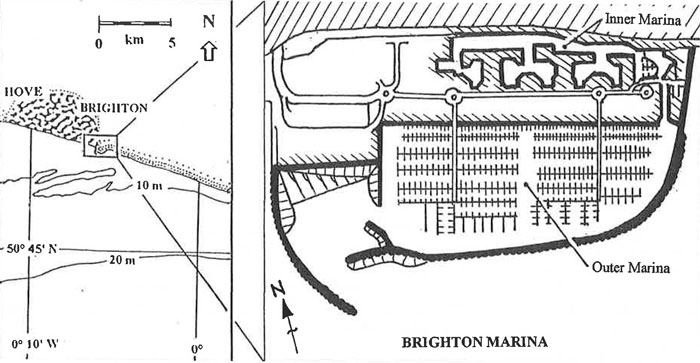SUSSEX MARINE SITES OF NATURE CONSERVATION IMPORTANCE
| Site: Brighton Marina | Ref. No. 18 | ||||||
| Location: About 2 km E of the Palace Pier, Brighton | Other conservation designation?: No |
||||||
| Lat./Long. position of centre of site: 50° 48' 50" N 0° 6' 20" W |
OS grid ref. of centre of site: |
Author: Robert Irving |
|||||
| Sea bed type: Mud seabed, but most interest in the communities associated with the floating pontoons of wood, polystyrene & concrete. |
Depth range (below chart datum): 0-3 m |
Date identified: June 2001 |
|||||
Summary
Brighton Marina was built between 1971 and 1999, though the Outer Harbour was operational by 1980. The construction of the Marina obliterated Black Rock Ledge, an Upper Cretaceous chalk exposure of considerable geological and marine biological interest. It is apt that such a development has now acquired a marine biological interest all of its own, quite different from that which it possessed before. The main interest now lies in the marine community which has colonised the floating pontoons in the Outer Harbour, though the Inner Harbour has the potential of developing similarly interesting, though quite different, communities adapted to brackish water conditions.
Biological Description
Two main types of structure exist in the Outer Marina: those that are floating (i.e. the concourses and the pontoons) and those that are non-floating (i.e. the pilings and the harbour walls). The floating structures provide the prime marine biological interest of the site, as these rise and fall with each successive tide, their undersides never being exposed to the air. This fact, coupled with the extreme shelter which the Marina's east and west breakwaters provide, has allowed for a diverse and prolific community to have developed just below the surface, featuring many species which are usually encountered in water depths of 10 m or more (i.e. well below low water mark). Of particular note are the sponges (e.g. Suberites ficus, Halichondria bowerbanki), anemones (e.g. Metridium senile, Sagartia sp.), and ascidians (e.g. Ciona intestinalis, Ascidia mentula and Ascidiella aspersa). Many individuals grow surprisingly large, reflecting the sheltered conditions and slightly elevated water temperatures. The non-floating structures (i.e. the pilings and the harbour walls) are subject to the full range of tidal movement and therefore support completely different communities, more characteristic of vertical zonation in the littoral zone.
A third habitat type is the Outer Marina's seabed. As a result of the extreme shelter afforded the Outer Harbour, the seabed here mostly consists of settled silt on top of soft mud, both of which are very easily disturbed. In amongst the mud protrude a number of man-made objects: mostly various items of rubbish such as drink cans and the inevitable shopping trolley. Harbour crabs Liocarcinus depurator are often seen on the bottom, together with juvenile flatfish. The enclosed water of the Marina is often a degree or two warmer than the open water outside, and this, together with the shelter on offer, makes it conducive to many species of fish and other open water species. The jellyfish Rhizostoma plumo, Aurelia aurita and Chrysaora hysoscella have been recorded from here, together with species of mullet, eels, wrasse, bass, black goby, fifteen-spine stickleback and greater pipefish.
Justification
The subtidal communities which have colonised the floating pontoons in the Outer Harbour are unusual and rarely encountered elsewhere along the Sussex coast. The site permits these communities (normally accessible for study by diving biologists only) to be studied from the safety and comfort of dry land!
References:Irving, R. A. 1999. Report of the Sussex Seasearch Project, 1992-1998 Sussex SEASEARCH Project, English Nature, Lewes, and Brighton & Hove Council, Brighton |
|||||||
| Sussex SEASEARCH dive nos.: (SEMCS Brighton Marina Survey, 1990/91) 714/1 | |||||||
Site Location

Diagrammatic representation of site: Brighton Marina


:Link to this page
Copyright Sussex Biodiversity Records Centre © 2025